AN EXTRAORDINARY DIGITAL ART SPACE AND A UNIQUE EXHIBITION BUILDING DEVOTED TO THE WORLD OF WINE
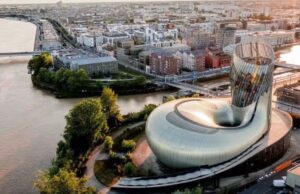
It had been some years since our last visit to Bordeaux, and the city has acquired a couple of great new attractions. One we were keen to visit turned out to be of the most remarkable cultural venues we have ever seen. We were familiar with Culturespaces’ Paris space, the Atelier des Lumières, housed in a former iron foundry, which itself is a fantastic venue that we always try and visit every time there’s a new show. Their latest venue in Bordeaux, the Bassins des Lumières, is the massive concrete structure built by the Nazis in 1941 as one of their Atlantic submarine bases, now an extraordinary space for Culturespaces’ digital art shows. Another attraction we had earmarked is the enormous Cité du Vin, a large, striking, modern building created to celebrating the world of wine and its heritage, not just in Bordeaux, but around the world.
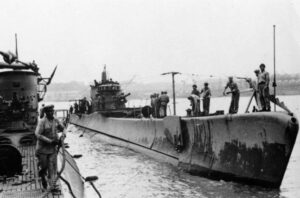
Following the fall of France in June 1940, the port district of Bacalan in the north of Bordeaux on the Garonne had been chosen by the Regia Marina Italiana to station their “Betasom” fleet of submarines (BETASOM is an Italian acronym of Bordeaux Sommergibile). The main purpose was to enable them to participate in the Battle of the Atlantic from 1940 to 1943 as part of the Axis anti-shipping campaign against the Allies. This base could house up to 30 submarines, and it had dry docks and two basins connected by locks.

The Italian Admiral was under the operational control of Rear Admiral Karl Dönitz, the Commander of the Submarines for the German Kriegsmarine. Dönitz was pragmatic about the Italians, seeing them as inexperienced, but useful for reconnaissance and likely to gain expertise over time. Dönitz considered the Italians as displaying “great dash and daring in battle, often exceeding that of Germans, but less toughness, endurance and tenacity.”
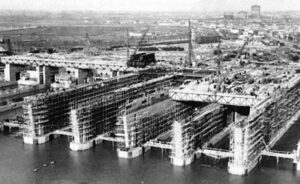
Dönitz soon noted the strategic interest of Bordeaux’s location, and in 1941 the Kriegsmarine (German Navy) moved swiftly to establish a chain of U-boat bases along the west coast of France. In September of that year, Dönitz proceeded to construct a protective U-boat bunker in Bordeaux, adjacent to the Italian base.

By October 1942, the first German U-boats were stationed in the new base, which went on to become the home of supply boats, mine-layers, torpedo transports, and above all, the 42-strong 12th Flotilla of very long-range boats. Some of the longest voyages of the war set out from Bordeaux, including a 225-day patrol that was completed in October 1943. After the capitulation of Italy in September 1943, five of their submarines in Bordeaux were also taken over by the Germans.
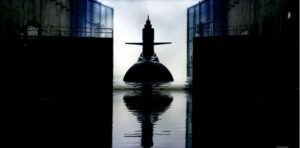
The scale of the U-boat base in Bordeaux is mind-boggling. The bunker, which covers a total area of 43,000 sq.m., is 245 m. long, 162 m. wide, 19m high and much of its roof is a near-indestructible 9.20m thick. More than 600,000 cubic metres of concrete were used to build it, making it virtually indestructible. There are 11 berths in all, separated by thick concrete walls. Pens 1 – 4 are wet docks, each of which is 20 m wide and 106m long, and could each house two U-boats. The rest of the pens are 14m wide dry docks, ranging from 96m to 104m in length. Each could house one submarine, the water being removed whenever necessary through the use of powerful pumps.

Construction of the bunker was only completed in mid-1944. It’s estimated that around 6,000 workers, mainly Spanish and Portuguese prisoners of war, were forced to work relentlessly day and night in appalling conditions. Many workers died in accidents, of exhaustion, or drowned. A memorial has been erected in tribute to those who took part in the construction, and particularly to those who lost their lives in the process. As one commentator remarked about the base’s new role: beauty flourishes from evil.
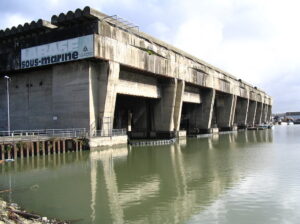
When Culturespaces took over 4 of the bassins (basins) the restoration works program included the floors, tanks, foundations, electricity, soundproofing, and the creation of technical areas for offices, production rooms, servers etc. They also built an annex to house a visitor reception area, a ticket office, and the obligatory shop. Two additional gangways were added in order to facilitate access, increase the floor space for visitors and increase the number of viewpoints.

The challenges of the site included not only the damage caused by bombs but the presence of water that is 16m deep. Projectors had to be located inside air-conditioned cases, and speakers had to be able to swivel independently to be able to control the flow of sound and be adaptable to the audio content of each production.
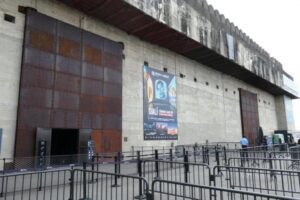
The art is immense in every sense. The light flows over and around you, making it a truly immersive experience. Despite the changes and renovations, it is by no means a “sanitised” space. Rather, it’s past life is still very evident, so that the visitor can fully appreciate and “feel” its past.

This enormous space is now the largest digital art centre in the world, according to the Bordeaux Tourist Bureau—and they are probably right! Programs of major immersive exhibitions since it opened in February 2020 include artists such as Gustave Klimt, Paul Klee, and Claude Monet. The exhibition we saw was in two parts, the longer program was about Salvador Dali’s work and the shorter was on Antonin Gaudi and his creation of the Sagrada Familia in Barcelona.

A major exhibition commencing 16 February 2024 is called ‘From Vermeer to Van Gogh – the Dutch Masters’, which sounds wonderful, and I would urge anyone planning to visit Bordeaux next year to book tickets for this well in advance.

The Bassins des Lumières is easy to get to using one of Bordeaux’s impressive trams, alighting at the stop for the Cité du Vin on Line B, and walking a short distance, or taking bus no. 9 from the city centre. The short ride passes many old warehouses that have been re-purposed as apartments, shopping areas and offices. Around the Bassins complex there are lots of bars, restaurants and shops that have recently transformed this area from an abandoned wasteland into a vibrant place to enjoy and explore.
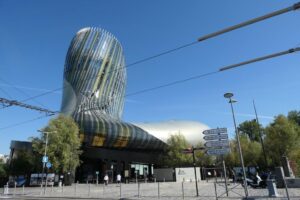
In the same neighbourhood as the Bassins des Lumières is La Cité du Vin, on the banks of the Garonne River. Inaugurated in 2016, it makes a strong architectural statement, with its distinctive curved shape that’s visible from much of the city, like a shining, 55m high beacon. The façade is constructed from glass panels and perforated, iridescent, lacquered aluminium. Its distinctive shape is said to be inspired by the movement of wine when it’s swirling in a glass, while others see gnarled, old vines. Its exterior colour changes with the sunshine and time of day, and the river is reflected in its panels.

The curve of the exterior is reflected in the interior volumes which is split into 10 levels, with 18 thematic areas. As well as exhibition spaces, there’s a reading room and a 250 seat auditorium for performances and concerts, screenings, conferences and talks.

The Cité du Vin is much more than a museum, rather, it’s a cultural centre that offers an interactive journey into the world of wine that includes videos of the world’s most beautiful wine regions, touch screens, sensory tables, interesting stories from winemakers, soundtracks and more. The audio guide you get with the entry price is a must, in order to enjoy the experience.
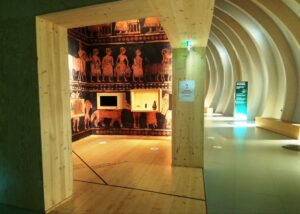
One area is where you dive into the history of wine and civilisation, another explores the latest trends in wine tourism, culture, design and much more. Another area introduces the visitor to grape varieties and the winemaking process, while another explores wine history, civilisation and culture, different grapes and wines. There are flat, interactive touch screens, surrounded by gigantic wooden bottle shapes, which help explore the major wine types, from red to sweet white wines, as well as sparkling varieties.
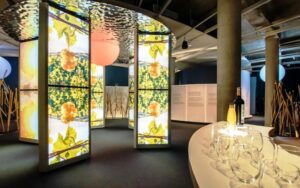
Another area is called “Art of Living”, where you’ll find the “buffet of the five senses.” There are a number of different food items from fruits to honey and biscuits, presented on two big tables, allowing you to explore different wine aromas. A new part recently added is the dinner table with a stunning visual art immersive experience. Near this is an area dedicated to the part waters and wars played in the history of wine around the globe. The last part of exhibition is dedicated to the Bordeaux wine region.
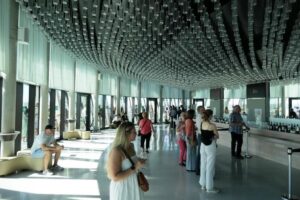
Finally, you need to go back to the ground floor and take the elevator to the 8th floor, at the top of the building. This floor is called the Belvedere. There are 3 tasting areas, and a 35m high exterior viewing area offering a unique way to taste the wines of the world while taking in a panoramic view of Bordeaux and the surrounding area. You can choose one wine from one of the regions and take your glass out on the balcony to enjoy the view.

These two latest attractions are a stunning addition to a beautiful city already blessed with so much to see and experience. Getting around Bordeaux has never been easier or more pleasant and inexpensive. The tram system is now so extensive that neighbourhoods once thought of as somewhat inconvenient or a little too far away, are now quickly and easily accessible. This also means that hotel options are even more plentiful than in years past, rather than necessarily having to stick to the inner CBD. The city is also blessed with many cafes, bistros and upmarket restaurants, as one would expect in the capital of the country’s wine region. As there are direct trains running between Bordeaux and Paris with journey times from a little over 2 hrs. up to 3 hrs., it’s the perfect destination for a short stay, although one visit is hardly enough!



Leave a Reply